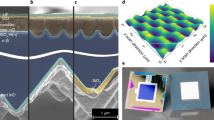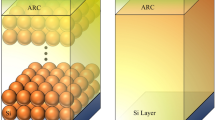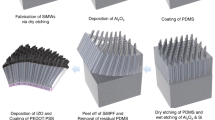Abstract
Nanopatterning has gained tremendous importance in the field of photovoltaics, as absorption of sunlight in solar cells can be enhanced drastically by proper engineering of photonic nanostructures1,2,3,4,5,6,7,8. However, despite intensive efforts, neither the ideal surface morphology nor the ideal scattering characteristics for optimum light trapping have been identified. Experimentally, a method capable of implementing arbitrarily designed surface morphologies directly into functional devices is desirable. Here, we establish a nanomoulding process that provides exactly such a platform, enabling precise, large-area, nanoscale patterning of functional zinc oxide films at low cost. We illustrate the application of nanomoulded zinc oxide films as transparent front electrodes in amorphous silicon solar cells, demonstrating excellent initial conversion efficiencies of 10.1%. In the quest to find the most efficient light-harvesting scheme, we anticipate that nanomoulding will catalyse the development and integration of exciting new nanophotonic structures.
This is a preview of subscription content, access via your institution
Access options
Subscribe to this journal
Receive 12 print issues and online access
$209.00 per year
only $17.42 per issue
Buy this article
- Purchase on Springer Link
- Instant access to full article PDF
Prices may be subject to local taxes which are calculated during checkout





Similar content being viewed by others
References
Zhu, J., Hsu, C-M., Yu, Z., Fan, S. & Cui, Y. Nanodome solar cells with efficient light management and self-cleaning. Nano Lett. 10, 1979–1984 (2010).
Garnett, E. & Yang, P. Light trapping in silicon nanowire solar cells. Nano Lett. 10, 1082–1087 (2010).
Kelzenberg, M. D. et al. Enhanced absorption and carrier collection in Si wire arrays for photovoltaic applications. Nature Mater. 9, 239–244 (2010).
Cao, L. et al. Semiconductor nanowire optical antenna solar absorbers. Nano Lett. 10, 439–445 (2010).
Han, S. E. & Chen, G. Optical absorption enhancement in silicon nanohole arrays for solar photovoltaics. Nano Lett. 10, 1012–1015 (2010).
Atwater, H. A. & Polman, A. Plasmonics for improved photovoltaic devices. Nature Mater. 9, 205–213 (2010).
Sai, H., Fujiwara, H., Kondo, M. & Kanamori, Y. Enhancement of light trapping in thin-film hydrogenated microcrystalline Si solar cells using back reflectors with self-ordered dimple pattern. Appl. Phys. Lett. 93, 143501 (2008).
Battaglia, C. et al. Nanoimprint lithography for high-efficiency thin-film silicon solar cells. Nano Lett. 11, 661–665 (2010).
Lincot, D. Solution growth of functional zinc oxide films and nanostructures. MRS Bull. 35, 778–789 (2010).
Özgür, U. et al. A comprehensive review of ZnO materials and devices. J. Appl. Phys. 98, 041301 (2005).
Tian, Z. R. et al. Complex and oriented ZnO nanostructures. Nature Mater. 2, 821–826 (2003).
Law, M., Greene, L. E., Johnson, J. C., Saykally, R. & Yang, P. Nanowire dye-sensitized solar cells. Nature Mater. 4, 455–459 (2005).
Faÿ, S., Steinhauser, J., Oliveira, N., Vallat-Sauvain, E. & Ballif, C. Optoelectronic properties of rough LP-CVD ZnO:B for use as TCO in thin-film silicon solar cells. Thin Solid Films 515, 8558–8561 (2007).
Berginski, M., Hüpkes, J., Reetz, W., Rech, B. & Wuttig, M. Recent development on surface-textured ZnO:Al films prepared by sputtering for thin-film solar cell application. Thin Solid Films 516, 5836–5841 (2008).
Benagli, S. et al. High-efficiency amorphous silicon devices on LPCVD-ZnO TCO prepared in industrial KAI-M R&D reactor. Proceedings of the 24th European Photovoltaic Solar Energy Conference, Hamburg, Germany, 2293–2298 (2009).
Bailat, J. et al. Recent developments of high-efficiency micro-morph tandem solar cells in KAI-M PECVD reactors. Proceedings of the 5th World Conference on Photovoltaic Energy Conversion, Valencia, Spain, 2720–2723 (2010).
Yablonovitch, E. Statistical ray optics. J. Opt. Soc. Am. 72, 899–907 (1982).
Yu, Z., Raman, A. & Fan, S. Fundamental limit of nanophotonic light trapping in solar cells PNAS. Proc. Natl Acad. Sci. USA 107, 17491–17496 (2010).
Escarré, J., Söderström, K., Haug, F-J., Battaglia, C. & Ballif, C. High fidelity transfer of nanometric random textures by UV embossing for thin film solar cells applications. Sol. Energ. Mater. Sol. Cells. 95, 881–886 (2011).
Python, M. et al. Influence of the substrate geometrical parameters on microcrystalline silicon growth for thin-film solar cells. Sol. Energ. Mater. Sol. Cell. 93, 1714–1720 (2009).
Despeisse, M. et al. Resistive interlayer for improved performance of thin film silicon solar cells on highly textured substrate. Appl. Phys. Lett. 96, 073507 (2010).
Cuony, P. et al. Mixed-phase p-type silicon oxide containing silicon nanocrystals and its role in thin-film silicon solar cells. Appl. Phys. Lett. 97, 213502 (2010).
Battaglia, C. et al. Efficient light management scheme for thin film silicon solar cells via transparent random nanostructures fabricated by nanoimprinting. Appl. Phys. Lett. 96, 213504 (2010).
Ahn, S. H. & Guo, L. J. Large-area roll-to-roll and roll-to-plate nanoimprint lithography: a step toward high-throughput application of continuous nanoimprinting. ACS Nano 3, 2304–2310 (2009).
Lee, W., Ji, R., Gösele, U. & Nielsch, K. Fast fabrication of long-range ordered porous alumina membranes by hard anodization. Nature Mater. 5, 741–747 (2006).
Acknowledgements
The authors thank D. Alexander and M. Leboeuf for assistance with the FIB and AFM, respectively, W. Lee for providing the ATA master, Z. Holman and P. Cuony for careful proof-reading of the manuscript, and the Swiss Federal Energy Office and the Swiss National Science Foundation for funding (under project no. 101191 and grant no. 200021 12577/1).
Author information
Authors and Affiliations
Contributions
C.B. conceived the nanomoulding method and coordinated the work. J.E. carried out the first nanomoulding experiments. K.S. fabricated the nanomoulded grating. M.C. deposited the silicon layers. C.B. characterized the nanomoulded ZnO, processed and measured the cells, performed the data analysis and wrote the manuscript. M.D. led the silicon layer development. F.-J.H. led the nanoimprinting activities. Ch.B. supervised the work.
Corresponding author
Ethics declarations
Competing interests
The authors declare no competing financial interests.
Rights and permissions
About this article
Cite this article
Battaglia, C., Escarré, J., Söderström, K. et al. Nanomoulding of transparent zinc oxide electrodes for efficient light trapping in solar cells. Nature Photon 5, 535–538 (2011). https://doi.org/10.1038/nphoton.2011.198
Received:
Accepted:
Published:
Issue Date:
DOI: https://doi.org/10.1038/nphoton.2011.198
This article is cited by
-
Promising electrochemical catalytic steel electrodes structure coated by ZnO films for water treatment and water-splitting applications
Journal of Materials Science: Materials in Electronics (2022)
-
Synthesis, photocatalytic and antidiabetic properties of ZnO/PVA nanoparticles
Scientific Reports (2021)
-
Influence on the Haze Effect of Si Thin-Film Solar Cell on Multi-Surface Textures of Periodic Honeycomb Glass
Transactions on Electrical and Electronic Materials (2021)
-
Progress and prospects for ultrathin solar cells
Nature Energy (2020)
-
Enhancing the Efficiencies of Organic Photovoltaic and Organic Light-Emitting Diode Devices by Regular Nano-Wrinkle Patterns
Journal of Shanghai Jiaotong University (Science) (2018)



